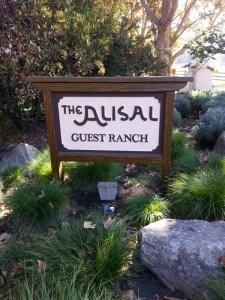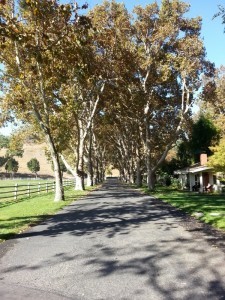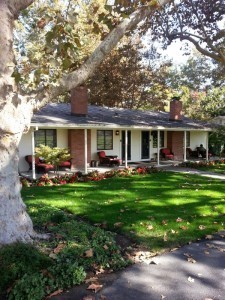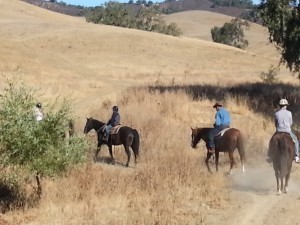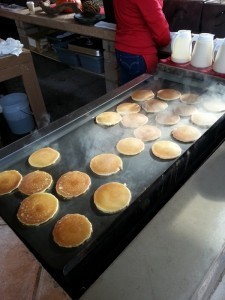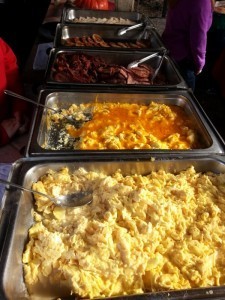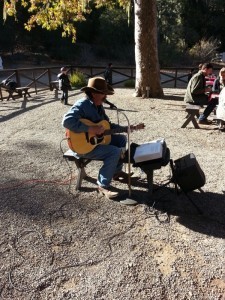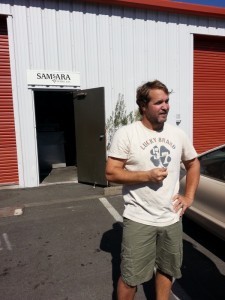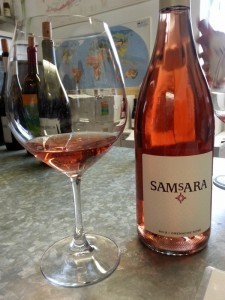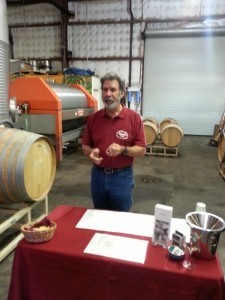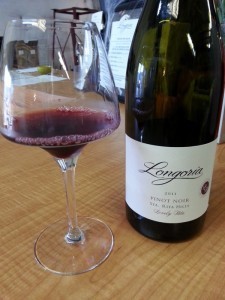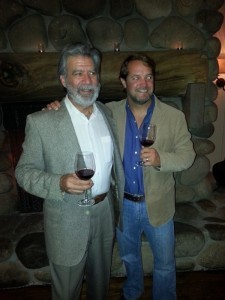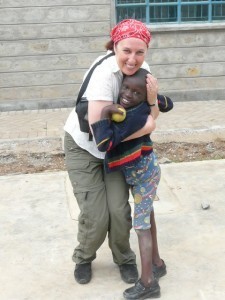Lisa Niver's Blog: We Said Go Travel, page 416
February 27, 2014
Botswana: The Luxury of a Mobile Safari
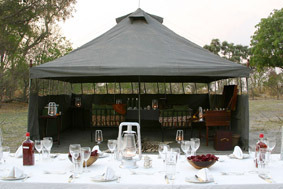 The mobile safari is becoming more and more popular and we are not surprised. A mobile safari can offer any standard of tent for any budget with the main emphasis being on the fact you have a private guide, and will stay at private campsites set up just for you. This is of course impossible on any kind of safari other than a mobile, and it also means that you can plan your route and really get into pristine wilderness areas which are not populated by other people and which have abundant wildlife. In Botswana a rustic mobile safari is the best way of seeing this expensive safari destination. The Botswana mobile safaris are some of the best value safari options in Africa, which goes slightly against the grain, since Botswana is actually Africa’s most expensive luxury safari hot spot.
The mobile safari is becoming more and more popular and we are not surprised. A mobile safari can offer any standard of tent for any budget with the main emphasis being on the fact you have a private guide, and will stay at private campsites set up just for you. This is of course impossible on any kind of safari other than a mobile, and it also means that you can plan your route and really get into pristine wilderness areas which are not populated by other people and which have abundant wildlife. In Botswana a rustic mobile safari is the best way of seeing this expensive safari destination. The Botswana mobile safaris are some of the best value safari options in Africa, which goes slightly against the grain, since Botswana is actually Africa’s most expensive luxury safari hot spot.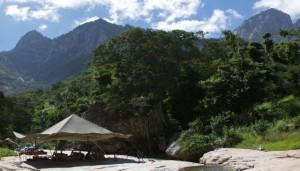 The bottom level involves dome tents with comfy mattresses on the floor and a floating canopy over your dining table and chairs. Your loo is a long drop outside the tent and your shower a bucket shower. You will go into unexplored areas with an expert private guide and private vehicle and will enjoy exclusive game viewing. This then goes up a level into stand up meru tents which have en suite loos and bucket showers at the back of the tent, and comfy camp beds. Your wash basin is placed outside the tent and early mornings spent admiring the view whilst washing your face with warm water are enchanting. Of course there is always another level – and the luxury mobile safaris are certainly that. Huge walk in tents with flush loos with a view, and copper bucket showers – four poster beds and antique campaign furniture populate these extraordinarily luxurious mobile tents.
The bottom level involves dome tents with comfy mattresses on the floor and a floating canopy over your dining table and chairs. Your loo is a long drop outside the tent and your shower a bucket shower. You will go into unexplored areas with an expert private guide and private vehicle and will enjoy exclusive game viewing. This then goes up a level into stand up meru tents which have en suite loos and bucket showers at the back of the tent, and comfy camp beds. Your wash basin is placed outside the tent and early mornings spent admiring the view whilst washing your face with warm water are enchanting. Of course there is always another level – and the luxury mobile safaris are certainly that. Huge walk in tents with flush loos with a view, and copper bucket showers – four poster beds and antique campaign furniture populate these extraordinarily luxurious mobile tents.
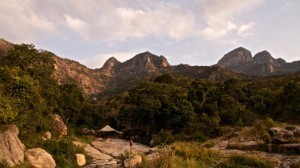 The best thing about a mobile camp is that you can plan your own safari, using a knowledgeable agent like The Luxury Safari Company you can plan your own route based on what you really want to get out of your safari, and where the game will be at the time of year you are travelling. Many of the best safari guides in Africa also run mobile safaris, so you can often find yourself being guided by an extremely knowledgeable man of the bush. In short, if you have time mobile safaris are the absolute best way of doing a safari.
The best thing about a mobile camp is that you can plan your own safari, using a knowledgeable agent like The Luxury Safari Company you can plan your own route based on what you really want to get out of your safari, and where the game will be at the time of year you are travelling. Many of the best safari guides in Africa also run mobile safaris, so you can often find yourself being guided by an extremely knowledgeable man of the bush. In short, if you have time mobile safaris are the absolute best way of doing a safari.
SPECIAL FOR WESAIDGOTRAVEL: 10% off all mobile safaris
For more information: Click here and mention We Said Go Travel for your 10% discount.
About the Author: Rose Hipwood lived, loved and worked in Africa for 7 years before founding The Luxury Safari Company four years ago. Specialising in off the beaten track luxury safaris you can rest assured that you will always have access to Africa’s most exclusive properties, the best safari guides and unrivalled first hand knowledge of Africa.
The post Botswana: The Luxury of a Mobile Safari appeared first on We Said Go Travel.
Weekend Escapes: Santa Barbara Wine Country
Sometimes all you need is a weekend getaway to escape the weekly grind. My recent getaway to Alisal Guest Ranch & Resort in Solvang, California, the heart of wine country, was the perfect destination. After a long week, we left Los Angeles after dark, and after traffic, to drive up to Santa Barbara. Two hours later we drove down a dark country road and found the driveway into Alisal Guest Ranch.
We settled into our private guest cottage, one of 73 in total. With no telephones or televisions, it was a well-needed escape from reality. Only a few minutes from the touristy streets of Solvang, Alisal Guest Ranch & Resort is a secluded hideaway that has been a full-service guest ranch since 1946. From horseback riding and a petting zoo to two 18-hole championship golf courses, a huge spa and fitness center and tennis courts to a 100-acre spring-fed lake for kayaking, canoeing and fly fishing to, of course, wine tasting, there are activities for everyone!
After a good night sleep, we woke up early the next morning for a breakfast ride. Accommodating all levels of riders (and a haywagon for those that don’t want to get on a horse), we hopped up on our horses and began a ride through the 50-some-odd miles of horse trails. About an hour later, we arrived at the Old Adobe for an outdoor breakfast of coffee, flapjacks, biscuits and live music. It was a bit chilly that morning so we warmed ourselves by the campfire and then got back on our horses to ride back to the Ranch.
In the afternoon, we headed out to the Lompoc Wine Ghetto. This industrial park of 19 tasting rooms was in full swing that weekend as harvest was underway. We visited two wineries on this visit (but you can spend an entire weekend tasting through the beautiful Pinot Noirs and other grapes from these top producers).
First stop: Samsara, a Sanskrit word meaning the eternal cycle of life, is owned by Chad and Mary Melville. They produce 1200 cases, all by hand, of Pinot Noir, Syrah and Grenache. They are focused on working with specific Vineyard sites and even specific rows within the vineyards, with a goal to really represent what is special about the selected rows. As a winemaker, Chad’s philosophy is to get out of the way and let grapes do their job and the result is elegant, sophisticated but approachable wines.
Second Stop: Longoria is owned by Rick and Diane Longoria and was established in 1982. They opened their first tasting room in Los Olivos in May 1998, but in December 1998, Rick became the first winery to be established in the yet-to-be-named Lompoc Wine Ghetto when he moved his winery operation into a 5,400 sq. foot industrial building there. In fact, Rick is considered the “Godfather” of the Lompoc Wine Ghetto. Today they produce 3000 cases of Pinot Noir, Chardonnay, Syrah and Spanish varietals (Albarino and Tempranillo), among others. These are wines that pair well with food as they are balanced, rich and high in acid.
After an afternoon of wine tasting, we returned to sit on our cottage porch and read and relax before heading to dinner in the Sycamore Room followed by drinks and live music n the Oak Room Lounge. Rick Longoria and Chad Melville joined us for dinner that night so we were about to enjoy more of their wines.
Sunday morning we woke up to have a full breakfast in the Ranch Room before hitting the road to head back to LA. While the trip was only 2 days, it felt like we had been away for a week. We were rested and refreshed and ready to start another week. Got to love a weekend getaway!
The post Weekend Escapes: Santa Barbara Wine Country appeared first on We Said Go Travel.
Road-tripping: Silver City Highway in Australia
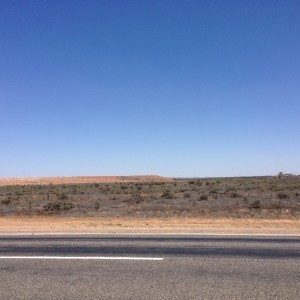 Road trips are like a good nights sleep – they foster a sense of freedom and possibility. Gather a carefully curated selection of travel buddies, songs and snacks and you have formed the foundations of an adventure full of a million memories and laughs.
Road trips are like a good nights sleep – they foster a sense of freedom and possibility. Gather a carefully curated selection of travel buddies, songs and snacks and you have formed the foundations of an adventure full of a million memories and laughs.
Choosing a destination can be tricky. Do you swim in the ocean? Climb a mountain? Taste wine from a plethora of wineries? They are certainly typical road trip destinations in Australia, all of which are wonderful. But there is one particular road trip that provides inspiration to-the-max and instills a desire to live life to the up most. It is a journey to the desolate land known as the Australian Outback.
A road trip to the Outback is an opportunity to encounter vast plains, brilliant red soils, wild flora and fauna and warmth from constant beams of sun. This space is a far cry from the lives of most Australians, 90% of whom live on the coast of Australia in built-up urban environments. The sparsely populated area of central Australia is a welcome environment when juxtaposed to the hustle of city life. The Outback presents a rich history and breathing space.
The Silver City Highway travels north through the Outback and is approximately 679 km long. The road was built to connect the mining town, Broken Hill (known as the Silver City), with areas to the north and south. It runs through the middle of NSW from the edge of the Victorian border to Queensland and is the wide-reaching road for a journey with friends.
It’s the 297km drive from Mildura (on the boarder of Victoria and New South Wales) and Broken Hill that is a true vision of sparse beauty and inspiration. The ground surrounding the road is a rustic red and filled with little shrubs known as Casuarina, which have a silver glisten to them. The surrounding plains are vast and met by a shimmering blue sky.
There are only one or two petrol stops on the stretch of road, which means there is plenty of nature and space to seduce you. Wild goats feed in sporadic parts of the strait and if you are lucky enough you will spy emus dashing across the land, kangaroos having a nap in the shade and wedge tailed eagles with their enormous wingspan on the hunt for dinner.
A good music playlist is essential for the three-hour drive along the Silver City Highway. A must-do activity is to pull over on the side of the road, leave the passenger doors open, blast an upbeat song and dance on the red soil like no one is watching, because they aren’t. The feeling of freedom, joy, elation, possibility and connection with the land in that very dancing moment is something of marvel.
Of course there are loads of activities to partake in at either end of the Mildura to Broken Hill section of the Silver City Highway.
At the Mildura end of the road in Buronga you will find Australia’s oldest inland Botanic Gardens with an impressive 1600 rose bush garden. Just down the road from the gardens you will find Orange World. You can take a tour of the citrus farm, have your photo taken with a giant orange or grab a freshly squeezed glass of juice for as little as $2 AUD.
When you arrive in Broken Hill, and are tired out from singing and dancing, the perfect resting place for dinner and a drink at The Palace Hotel. The Palace is a quirky pub with detailed murals painted all over the walls by Indigenous artist Gordon Wayne. Along with enjoying the quality pub food it’s also exciting to know that scenes from the iconic Australian film Adventures of Pricilla Queen of the Desert were filmed there.
A visit to Broken Hill would not be complete without a trip to the Living Desert Sculptures. Take some wine and cheese and sit on top of the hill overlooking Broken Hill as the sunsets. It’s a feeling of blissful freedom.
Road tripping is the ultimate time of indulgence and is a reminder that colour and movement makes for true adventure – no regrets.
About the Author: Anna Hickey is a freelance writer based in Melbourne. Anna has a love of food, words and travel. She likes to explore and create, especially in the kitchen where she makes and blogs about healthy recipes.
Thank you for reading and commenting. Please enter our next Travel Writing competition and tell your story.
The post Road-tripping: Silver City Highway in Australia appeared first on We Said Go Travel.
February 26, 2014
Southern Comfort in the UK.
Two things immediately come to mind when I think of Sussex, England: the best fish and chips I’ve ever had and the South Downs.
The fish and chips were consumed in the cafeteria of a British Homes Store in Brighton. The memory of the crispy brown batter encasing tender flaky white fish and the most amazing chips fried to perfection with not a hint of grease sustains me to this day when I am hungry.
On a deeper note, my love affair with the South Downs is going on almost 40 years now. The Downs are perpetually green undulating hills that cross several counties in southern England. To me they are a homing beacon, gentle sentinels ever present and safe that let me know I am always welcome no matter how much time has passed since my last visit.
They are also home to a hidden treasure where I have spent many hours contemplating and simply enjoying its beauty and history. Nestled at the foot of the Downs in the village of Clayton is the church of St. John the Baptist. St. Johns is not grand and doesn’t dominate a skyline like St. Paul’s. It is a small anglo-saxon church and I fell in love with on sight.
It was early winter and chilly outside when I first went to St. Johns. Inside the church was chilly too, lit only by the pale grey of the overcast sky filtering through the stained glass windows. In this soft light I had my first glimpse of the wonderful 12th century frescos painted on the walls.
The frescos were discovered in 1893 by workmen making repairs and depict scenes of the final judgment day. It’s believed they were painted by friars from St. Pancras Priory in Lewes, Sussex. Using earth tones of reds, browns and ochers, this incredible effort must have taken months and maybe even years for the monks to complete with only daylight and candles to work by.
Above the arch leading to the chancellery is the figure of Christ seated on a throne with the apostles in attendance on either side, their expressions both pious and humble. On another wall is an image of the devil herding the damned towards hell, and his expression gives you the idea that he is thoroughly enjoying his task.
The murals also seem to change with the seasons. In the brighter light of late spring and summer the colors are more more vibrant as they probably would have appeared when first painted. In contrast, the muted light of fall and winter gives them a somber appearance which is perhaps more fitting for the Last Judgment.
In the fall the altar is a burst of color, surrounded by pumpkins and baskets of corn and turnips from local farms and cottage gardens. I feel this is how the altar must have looked for centuries in the harvest season with people bringing their offerings in thanks for a bountiful growing season.
I’m not sure what it is that draws me back to this part of the world over and over again. The wall paintings in the church are always worth coming to see and if you like to read headstones in graveyards this one will not disappoint. The village green nearby beckons you to sit and marvel at the splendor of the South Downs. But those are just reasons to return, not explanations. And maybe I’ll never figure it out and that’s okay. This part of southern England will always be a haven of peace for me in a country that I love, and that’s okay too.
About the Author: My name is Louise Zontek. I was born in Sydney, Australia and have lived in the United States since 1980. I love to travel and have a particular passion for ancient civilizations and history.
Thank you for reading and commenting. Please enter our next Travel Writing competition and tell your story.
The post Southern Comfort in the UK. appeared first on We Said Go Travel.
A moment in life in Vietnam
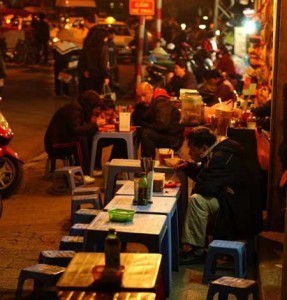 It was almost a kind of sadness when, right before leaving my country, I realized that I didn’t know much of it. I have traveled a lot to different countries, I have memorized the name of strange streets, have stopped to take pictures of places I may be able to visit just once, have walked down the road looking, observing, learning, remembering, trying to carve everything seen into my heart. But I didn’t know much about my country. I have never taken enough time seeing around. I know all the famous visiting sites, but I have not been there. Tourists come and go – and me, I live here for eighteen years, knowing a lot but also knowing very little. I wish I had used my time here like a traveler – like someone who is burnt with passion and eager to discover new things, someone who captures every precious moment carefully, knowing it will soon pass. This place, however, has already become a part of myself, and so I didn’t bother examining it. Now when I was about to leave, I suddenly became a tourist in my own country, trying to notice every small thing I saw every day but was oblivious to.
It was almost a kind of sadness when, right before leaving my country, I realized that I didn’t know much of it. I have traveled a lot to different countries, I have memorized the name of strange streets, have stopped to take pictures of places I may be able to visit just once, have walked down the road looking, observing, learning, remembering, trying to carve everything seen into my heart. But I didn’t know much about my country. I have never taken enough time seeing around. I know all the famous visiting sites, but I have not been there. Tourists come and go – and me, I live here for eighteen years, knowing a lot but also knowing very little. I wish I had used my time here like a traveler – like someone who is burnt with passion and eager to discover new things, someone who captures every precious moment carefully, knowing it will soon pass. This place, however, has already become a part of myself, and so I didn’t bother examining it. Now when I was about to leave, I suddenly became a tourist in my own country, trying to notice every small thing I saw every day but was oblivious to.
One thing in Vietnam is that there are a lot of small coffee/food shops along the street. Sometimes the “shop” is made up just from a couple of small tables and stools, and the menu is simple with limited choices. Still, from the morning to the evening, there are always people sitting there, either with a group of friends or alone. I used to think of them as people with lots of leisure time. I, as a typical teenager, had so many fun and wild things to chase after rather than sitting down in a random road-side shop. Yet I was trying to do things undone, so one day I sat down on the plastic short stool and ordered a glass of tea.
It turned out that there are many things I can do there, rather than just dazing off as I previously (and wrongly) thought. It was a good place to tighter the relationship with friends – here, in this simple shop, on the small stools, people just talk to one another freely. No eyes sticking on the large movie scene for hours without any communication, no focusing on how to throw the bowling ball too much that conversation becomes unimportant… – there aren’t even fancy dishes or drinks to take your attention away. If you come alone, you can always talk to the shop owner. If you want to enjoy a peaceful and silent moment, this is also the place. The open-air shop makes it is so connected to nature. You can look at people passing on the road, wondering where they are going and why they are always in a rush. You can look at the school girls in ao dai just finish school that are walking down, recalling your youthful memories. How often do you actually get to stop in life to observe and pay attention to the surrounding? So many deep thoughts ran across my mind like wild horses as I looked at the street and the houses I thought I knew so well for the first time in details. I am always moved by simple scenes. On traveling, I always try to discover small corners that seem to be insignificant but can reflect the culture and tradition of the place more than its fancy mask. I guess to me, the beauty of Vietnam is that there are so many places like this to calm myself down. Sometimes the place that needs to be discovered the most is your nearest place. Sometimes taking a break to slow down and watch the world moving is a wise decision. Sometimes giving yourself a little time and space to ponder about life is meaningful. In the current society where there are fast-food chains everywhere and people are always seem to be hurry, I love to see places that remind me to stop once in a while and reflect things.
About the Author: An Nguyen loves traveling, writing, and writing about her traveling. She is studying abroad and plans to use this opportunity to travel around as much as possible.
Thank you for reading and commenting. Please enter our next Travel Writing competition and tell your story.
The post A moment in life in Vietnam appeared first on We Said Go Travel.
Be Still along the Sea in California
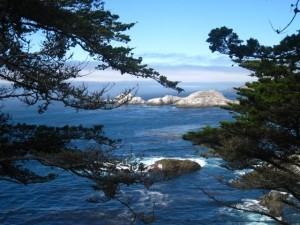 I recently returned from John Steinbeck country. This slice of the West Coast boasts some of the most scenic views in the world as well as rich farmlands bursting with fruits of the region. Fresh strawberries, lettuce, artichokes, avocados, and herbs are in abundance. The area oozes health of the physical, and spiritual variety. Temperatures are consistent year round, 65-75 degrees and the people seem to be grateful, simple, laid back, and friendly. Why wouldn’t they be? Essentially they are dwelling in Shangri-la.
I recently returned from John Steinbeck country. This slice of the West Coast boasts some of the most scenic views in the world as well as rich farmlands bursting with fruits of the region. Fresh strawberries, lettuce, artichokes, avocados, and herbs are in abundance. The area oozes health of the physical, and spiritual variety. Temperatures are consistent year round, 65-75 degrees and the people seem to be grateful, simple, laid back, and friendly. Why wouldn’t they be? Essentially they are dwelling in Shangri-la.
Drives along the coast and Big Sur unveiled a painting: layers of heather, azure, turquoise, and cerulean waters pulverizing into softness, smoky white sands. In my travels, I have never seen sea water and terrain so diverse. Venturing down the cliffs to the virgin beaches was a challenge, and commercially manufactured WARNING signs interrupted the sense of transcendence. The cliffs too were a blanket of unlikely growth with hard, red clay surfaces unable to hold back the riot of dark green, aloe vera like plants known as Ice Plant, hot pink flowers sporadically peeking out from their tops. Adding to the mystery and ethereal quality of it all, was a gossamer shroud of fog, like the sheerest of lingerie, sensually beckoning visitors to ignore the signs, throw caution to the wind and pursue her gifts. Mesmerized by the seduction of the mermaids call, it was worth the risk to scale the cliff and drop into another world. Charleton Heston when he lands on the beach in Planet of Apes came to mind. This was an area where change could take place… if you let it. The elusive feeling of oneness that we so desperately seek through literature, prayer, and human interaction just slipped in, with no effort on my part. I became the sky, the sea, the land. It took me.
One evening, our fire logs, food, and blankets in tow, we trekked down to a more populated beach, Carmel by the Sea. It was bonfire and cookout night! Navigating the steep steps and climbing over mounds of rock to reach an alcove, my first thought was, “Good Lord, I hope we leave before dark.” I knew we wouldn’t be because the sun was sliding slowly down the horizon when we arrived. We started our fire, set up our grill and cooked our burgers. By the time our bellies were full, the sun had been swallowed up by the sea, leaving our only remaining light to be a 2-3 foot perimeter around our tiny, blazing fire. The air had taken on a nippy tone, and everyone gathered closer to the flames to stay warm. It got dark- pitch black. I looked for the moon. It was nowhere to be seen. There were a few other little campfires dotting the beach, and I could faintly see black sillouhette’s outlined by the orange flames reassuring me that there was other civilization out there somewhere. The sound I heard off in the distance, reassuring me I was right where I needed to be, at the moment, was the intense crash of monster waves as they beat the sand into submission, the gritty granuales at the mercy of the whims of the water. The cadence of the sound was like a mantra- reassuring in its sameness. Hidden inside the noise of the water, a whisper, tickling my brain. It said, “I’m in charge. Enjoy this moment, for in this instant is all the wisdom you will ever need.” I felt every muscle in my body relax as I focused on nothing except the sticky sweetness of a melted marshmallow dissolving in my mouth. Time slowed and my mind felt like it had been shot full of Novocaine, all tingly, and devoid of man made thought. Just one sensation remained. I didn’t think the word “awe”… I felt it with every cell in my body.
Soon, the fire was reduced to a few burning embers. My skin resembled the scales of a native Pacific salmon to the touch. I had become truly one with the sea and it was time to slowly re-emerge into the reality, I wasn’t of the sea, and needed to get warm. With that recognition, the moon suddenly rose, our heavenly flashlight, illuminating our path. Over the rocks, and up the side of the cliff. It was as if God said, “See. All you need to do is enjoy every moment of your life, second by second, with no thoughts for the future. When its time to move forward, I will provide you with all the and light you need to get to your next destination.”
A bonfire on the beach wasn’t in my travel plans particularly. I had no thoughts of indulging in its simplicity. I had a schedule of sights to see and things to do. But, it was one of the best things about my trip. We are constantly receiving gentle reminders we aren’t in charge of the Universe, and the best laid plans, are no plans. Go with the flow, and trust that the journey will take you where you need to be; to places purposeful and meaningful to your particular trip. And the best laid lives are those who allow their journey to take them. The predictable, consistent, tides ebbed and flowed without my help. The sun set beautifully over another day and the moon rose just exactly when it needed to.
Viva the end to struggle!
About the Author: Rebecca Mahoney is a free-lance writer with a love of enlightenment, truth and travel.
Thank you for reading and commenting. Please enter our next Travel Writing competition and tell your story.
The post Be Still along the Sea in California appeared first on We Said Go Travel.
February 25, 2014
The Place that Reveals in Maine
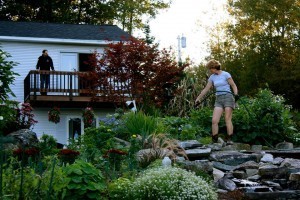 I’ve found that a city will swallow you up, make you feel anonymous and newborn as it casts you in its bricks, molds you and shapes you until you fold seamlessly into its walls. But a small town will be a mirror. A small town will reveal and inspire you with your own history. A small town will call you home.
I’ve found that a city will swallow you up, make you feel anonymous and newborn as it casts you in its bricks, molds you and shapes you until you fold seamlessly into its walls. But a small town will be a mirror. A small town will reveal and inspire you with your own history. A small town will call you home.
I’m not able to go home often, but on a late afternoon in April I succumb to a craving. A drive North, away from Friday night Art Walks, the discomfort of men in suits and Manhattans served straight up; away from the monotony of walking across crosswalks and waiting on red lights to turn green. I’m heading toward the place that cradled me, that rocked me in its streams, tried to keep a gentle hand on my shoulder but ended up giving a gentle push instead; a place that has retreated humbly into the abundance of Maine’s open spaces, Winterport, my hometown.
Winterport is a village on the Penobscot River. Route 1A intersects it’s town center where you’ll find a gas station, an antique store that’s never open, two breakfast spots, a recently-opened BBQ joint and a mermaid-themed bed and breakfast.
Ten minutes out of downtown is the road that I grew up on, where my parents still live, Riverview Heights. I remember the day they paved it. I’ve never strapped roller blades on so fast. Nine years old, the fastest girl in the world. Legs in a squat, a stick of chalk in each hand, sparks of pink dust surrounding me as I fly.
Nearly two decades later, I pull into my driveway. Bald Hill is majestic, catching fire as the sun sets behind it in a halo. Inside, my dad is snoring behind the closed door of my parent’s room. He was on nightshift last night at the casino in Bangor.
From our porch, I can see my mother literally pushing boulders around in my backyard. My mother is a soft-spoken, gentle nurse. She’s 5’7” and maybe 140 pounds. She has the prehistoric strength of a triceratops.
Throughout our white birch forest, there are massive slate boulders. Over the course of my life, I have observed my mother tumbling passionately into her obsession with rocks. She told me once that each boulder tells her where it needs to go. As she walks through her gardens, she can recount the history of every rock, how it came to sit as a stoic placeholder in her massive walls around us.
As I watch her now, fiddling around with the 8-foot rock rake my sister got her for Christmas, I know I am home.
I walk down over the hill and wrap my arms around her mud-dusted shoulders. As if I had always been there, she grabs my wrists and squeezes. I know she is closing her eyes.
Up at the house my father has awoken. “Let’s go for a bike ride,” he calls from the porch.
In my family, the word “bike” does not mean custom fixed-gear vintage Schwinn. A bike is a 1982 Iron Head Harley Sportster, that’s emergence every year is the first real rumble of spring.
A “bike ride” is a trip to the Steamboat gas station, where my father will buy a 6-pack of Coors Lite, and I’ll wedge it between us for the ride home.
I bust through our screen door and leapfrog onto the back.
“Just around the block,” my dad says.
But the block is never enough. We head up the steep hill of the Cove Road, and I grab a little tighter to keep from shifting back. It took me an entire summer to pedal my 10-year-old legs up that incline, but there was nothing sweeter than tasting the gravel wind on the way down.
We fly past the abandoned cemeteries and cow pastures that I grew up in, the same fixtures from my mother’s childhood. She grew up here too.
In many ways Winterport resembles every tiny Maine community. Families have risen generations here, each one swimming in the Marsh Stream and acting in the Nativity Pageant every year. There isn’t much here to put in a guidebook, and even though they may have driven through on their way to some distant, coastal town, many passerby will not remember Winterport. We’re just a little coordinate, just enough time to say, “This is quaint.” And we’re already fading in a rearview.
But here, I can close my eyes. And I can allow myself to be cradled. As the chickadees chirp atop the maples and the sweet spice of gasoline makes me greedily breathe deeper, I know that I will always be of this small place, this place that reveals me.
About the Author: Emma Thieme is a fourth-generation Maine girl currently living in Portland. Emma is a jewelry-maker, a bartender, a dancer, and a seamstress, but most of all she is a writer.
Thank you for reading and commenting. Please enter our next Travel Writing competition and tell your story.
The post The Place that Reveals in Maine appeared first on We Said Go Travel.
Reaching for the sky in Kenya
Caroline unraveled from a tangle of ragamuffin children onto the compound of caked earth and crumbling concrete. She was an explosive meteor shower in her thin psychedelic planet-themed pajamas: zigzagging across the yard, shooting a ragged football and darting through the ‘don’t-mess-with-me’ older boys. She was there, then gone, before reappearing on a rusty metal slide, skinny limbs flailing. I lost her, then saw her again, arching a rainbow across the yard on a tyre-swing and tumbling blurry cartwheels, feet to the sky.
A dark shadow blocked the sunlight. I looked up and there was Caroline, standing stock-still in front of me. She glanced at me shyly and offered “Hello.” Then she was pulling me down on the step beside her, gripping my hand with expectation.
With every overland truck that stopped by Mji Wa Neema, Hope orphanage, in the ramshackle Rift Valley town of Gilgil, Caroline scooped up a handful more English words and stored them like nuggets of gold in her head.
I offered her words in a story:
“Once upon a time there were three bears…”
Caroline cocked her head, puzzled.
“Do you know what bears are?” I asked. She shook her head no, and I started again:
“Once upon a time there were 3 simba – Mama Simba, Papa Simba and Baby Simba. One day Mama Simba made a pot of ugali for breakfast, but the ugali was too hot (I flapped my hand in front of my mouth), so they left the ugali to cool and went for a walk on the plains…”
Caroline listened, mouth forming a perfect O as I mimed my African version of The 3 Bears.
Upstairs in her dormitory, Caroline showed me all her belongings contained in her bedside cabinet: a set of clothes, a knitted teddy and a well-thumbed magazine about space. As my son sat huddled together with Caroline, pale porcelain skin and fiery-red hair contrasting with rich deep mahogany, I heard Caroline’s story: Parents lost to AIDs; an alcoholic grandfather who scarpered; three children left alone; uncovered and taken to the House of Hope.
In Africa, I had sailed on dhows, eaten baked fish on sandy atolls and snorkeled in the Indian Ocean. I had camped out in the Serengeti bush with nothing between me and the lions, rode across the grasslands on a camel and danced with the Masai.
But it is that dirt yard in a small town in Kenya, I remember best of all. And Caroline: rough, tough, fierce and bold – a survivor.
Back in England, limp yellow leaves drip from the branches of my cherry tree. Here the night nips. Six thousand miles away, the paw-paw tree in Caroline’s compound is laden with fruit. There the night wraps the red earth of Kenya in an ink-blue blanket of warmth. Above Caroline’s tree and mine, a pale marbled moon hangs suspended between the stars.
As I look up into the sky, I think of Caroline in her psychedelic, planet-themed pajamas, and I wonder if she is looking up too. And it occurs to me: we may live in different worlds, separated by continents, but we share the same view.
About the Author: Helen Moat spent her childhood squished between siblings in her Dad’s Morris Minor, travelling the length and breadth of Ireland. She’s still wandering. Helen was runner-up in 2011 British Guild of Travel Writers Competition and was highly commended in the BBC Wildlife Travel Writing Competition in 2013.
Thank you for reading and commenting. Please enter our next Travel Writing competition and tell your story.
The post Reaching for the sky in Kenya appeared first on We Said Go Travel.
Long Minutes and Lost Hours in Indonesia
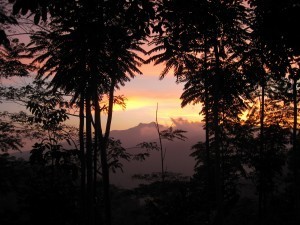 The bus stops on a winding road as the sun begins its careful descent behind the hills. On public buses, frequent stops are common. Bathroom break on the side of the road? The succulent smell of freshly cooked corn? Bags of just-picked fruits? Picking people up? Dropping packages off? For anything and everything. Nearing the end of a ten hour journey on this roller coaster-like “highway”, I figure the stop is related to the empty bottles now rolling along the bottom of our dusty, squeaking bus.
The bus stops on a winding road as the sun begins its careful descent behind the hills. On public buses, frequent stops are common. Bathroom break on the side of the road? The succulent smell of freshly cooked corn? Bags of just-picked fruits? Picking people up? Dropping packages off? For anything and everything. Nearing the end of a ten hour journey on this roller coaster-like “highway”, I figure the stop is related to the empty bottles now rolling along the bottom of our dusty, squeaking bus.
By now I’m used to this, to long hours in transit, to even longer hours waiting. Having spent the past three months traveling by public means, I can safely and easily say I’ve spent over 250 hours in transport or waiting for it. “Rubber time” they say, the minutes stretching to hours and the answer “sebentar lagi” (in a bit) when you ask about anything relating to time. I look out the window and let the cool breeze of our current location rush over me. The beauty of Golden Hour grows closer; soon everything will be painted in warm tones as the sun’s finger-like rays reach out one last time before saying goodnight.
The air is quiet; for once the bus isn’t pumping out dance music at insane volumes with a bus-shaking bass. It’s taken a while but I’m trying to appreciate each minute as it comes, not live in the previous one or the expectation of the next. To travel here is to come to terms with the idea that time isn’t money, time is flexible and there’s plenty of it. To rush, to be rushed, to become impatient is laughable.
A passenger steps back on the bus; he’s now got three chickens by the leg, they dangle looking confused. I look out the windows wondering where they came from; no shops, no houses. Before I come to any conclusions, the bus lurches and we’re off again.
The colors of the sky saturate and bleed vibrantly. I watch through the trees, the mountains in the distance look like they were cut out from the sky, their darker forms in stark contrast to the sun’s show.
The bus slows to another stop in front of two men sitting atop carefully bundled branches. The driver jumps out to inspect as his helper climbs the bus, preparing to receive whatever is picked out. A few words are had before bundles are lifted up and strapped down. Two women watch the transaction as they chat, picking grey hairs out of each other’s manes. The bus jolts again and the village streams by. Children push tires with sticks, such a simple form of entertainment extracting such utter enjoyment as teeth bare through huge grins. With far less television, no laptops, or videogames, no Hollywood movies telling them what the world should be, I envision their imaginations run deep, in vivid colors and without limits.
The air grows warmer as we descend from the hills; we sweep around bends, honking our way around motorbikes and other cars. Across from a soccer field we stop to refuel the bus’s thirsty belly. It’s Sunday and the entire town is out. Little boys in brightly colored uniforms run around the field as vendors sell tasty goods. The bell of the meatball soup cart rings, the ice cream man strolls by, kids eat fried treats on sticks with fingers covered in sauce, dripping to the ground.
A loud click signals a full tank and the engine revs, the road winds, ascending again toward a higher altitude. Before the sky fades to its deep dramatic blue, we pass through another small village. Groups of girls walk toward the river with buckets and towels in tow, preparing for their nightly bath. Others walk with towel-wrapped heads in the other direction, giggling. Little boys run through the riverbed, turning routine to game.
I sit back and take stock; my legs ache from cramped positioning, my back from the seat, my head from nodding off and then slamming into the window on a sharp turn. The hours are long and uncomfortable, my time in Indonesia has been difficult and often fraught with frustration but its forced me to learn that time doesn’t always need to be measured and marked by numbers. Communal bonds, laughter, it’s how you use your time that defines each day.
The cool air spills over my face. I try not to enumerate my day by how far I’ve gone or how fast, but what I’m able to take from the in-between. It’s about the slow moments and glimpsing life as it’s lived in another small part of the world.
Forget the numbers, embrace the long minutes and those lost hours.
I stretch my arms, checking my watch but no longer caring what I see.
About the Author: Jillian Gotfredson grew up in Kansas City, Missouri and have had the privilege of exploring parts of Central America, South America, and Southeast Asia. I spent 6 months working in Australia to fund my current adventure: 4 months in Indonesia.
Thank you for reading and commenting. Please enter our next Travel Writing competition and tell your story.
The post Long Minutes and Lost Hours in Indonesia appeared first on We Said Go Travel.
February 24, 2014
Oot and Aboot in Glasgow, Scotland
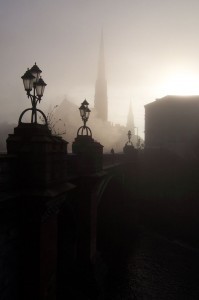 It was January and it had been raining for five days. As I walked down the street, shivering in my permanently damp coat, I considered my situation. I had moved from New York to Glasgow, Scotland without a job lined up or a place to live. My boyfriend and I were staying in a dirty hostel and had almost no money.
It was January and it had been raining for five days. As I walked down the street, shivering in my permanently damp coat, I considered my situation. I had moved from New York to Glasgow, Scotland without a job lined up or a place to live. My boyfriend and I were staying in a dirty hostel and had almost no money.
I feared that I had made a terrible mistake.
I had completed a postgraduate course in publishing at the University of Stirling that summer, and I enjoyed it so much that I decided I wanted to spend more time in Scotland. When I met with my supervisor before graduation, I told him that I was planning to come back to Scotland to pursue a publishing career after a brief visit home. He was silent for a moment.
“You’re going to leave New York, the home of English-language publishing, and try to find work in Scotland?” he asked.
I nodded.
“I would rethink that if I were you,” he said.
I didn’t. A few months after returning to New York, I packed up my suitcases again and moved to Glasgow.
My boyfriend and I chose Glasgow because it’s Scotland’s biggest city and the place we were most likely to find jobs, not because of any great desire to live there. I quickly realised that it’s the kind of place that takes some getting used to. Just when I would start to appreciate Glasgow’s Victorian architecture and free museums, I would encounter a group of drunken teenagers singing football songs and start to lose faith in the city again.
Glasgow is a city of contradictions – friendly yet frightening, cultured yet deprived, beautiful yet grimy. Glaswegians take it in stride, employing a great sense of humour and a slew of colourful slang words to make sense of their city’s incongruity. One of the first Glaswegian words that I learned is ‘geezeabrek’, which means ‘give me a break’. I decided that’s what I needed to do – give Glasgow a break. It was never going to be like New York or the peaceful village of Bridge of Allan where I’d lived as a postgraduate student. It could only be its wet, loud, graffiti-covered self, and I had to try to accept that.
While I struggled to get used to Glasgow, it did its best to turn me away. It gave me drug-addicted neighbours who stole my mail and regularly smashed the building’s windows. The only job opportunity it offered me was as a minimum wage temp in an area of the city called Maryhill, which is more commonly known as ‘Scaryhill’. It rained so I often that I forgot what the sun looked like. The dampness invaded my flat and mould bloomed on the bathroom ceiling and under my bed.
And yet I refused to give up.
I bought a waterproof jacket and sensible shoes and I walked all over the city, taking in Glasgow’s unique type of gritty charm. I grew to admire its soot-stained cathedral, red sandstone tenements and industrial bridges soaring over the River Clyde. Whenever the sun made a rare appearance, I rushed into the park with the rest of the Glaswegians, none of us wearing enough clothing or sunscreen. We drank beers all afternoon, leaving pink-skinned and tipsy.
I made friends with Glaswegians who swore creatively and often. I loved to listen to their banter, an easy back and forth of one-liners that rolled off their tongues in a series of long vowels and dropped consonants. Learning the dialect was like unlocking the heart of the city. I could speak Glasgow’s language, albeit with a New York accent. We could finally understand each other.
I knew my feelings about Glasgow had come full circle when a terrorist tried to drive a jeep full of explosives into Glasgow Airport in 2007. Baggage handler John Smeaton ran to the scene and kicked the driver, who was on fire, in the crotch. When asked about the incident, he said, “Glasgow doesn’t accept this. This is Glasgow; we’ll set aboot ye.” Smeaton became an instant folk hero, and fans set up a tribute site where people could donate money to buy him a pint.
To me, this was Glasgow in a nutshell – a fiery spirit, well-meaning toughness and the belief that a friendly pint can make everything better. Glasgow made international news and I swelled with pride in my adopted city. Aye, ye cannae mess wi’ Glesga, I thought.
I no longer live in Glasgow, but it remains the most important place I’ve ever been because it taught me that sometimes it pays to take a chance. When you have an open mind and a bit of patience, you can fall in love with the unlikeliest of places.
About the Author: Katie Lee is an American digital content developer based in England. She writes about Cheshire, Scotland and all the stuff in between at.
Thank you for reading and commenting. Please enter our next Travel Writing competition and tell your story.
The post Oot and Aboot in Glasgow, Scotland appeared first on We Said Go Travel.
We Said Go Travel
We Said Go Travel is a global community of over sixteen hundred writers with articles from every continent.
Stories are shared with photos and video from a perspective of the transformative power of travel. We Said Go Travel has hosted live and online events as well as travel writing contests around the world. ...more
- Lisa Niver's profile
- 57 followers


